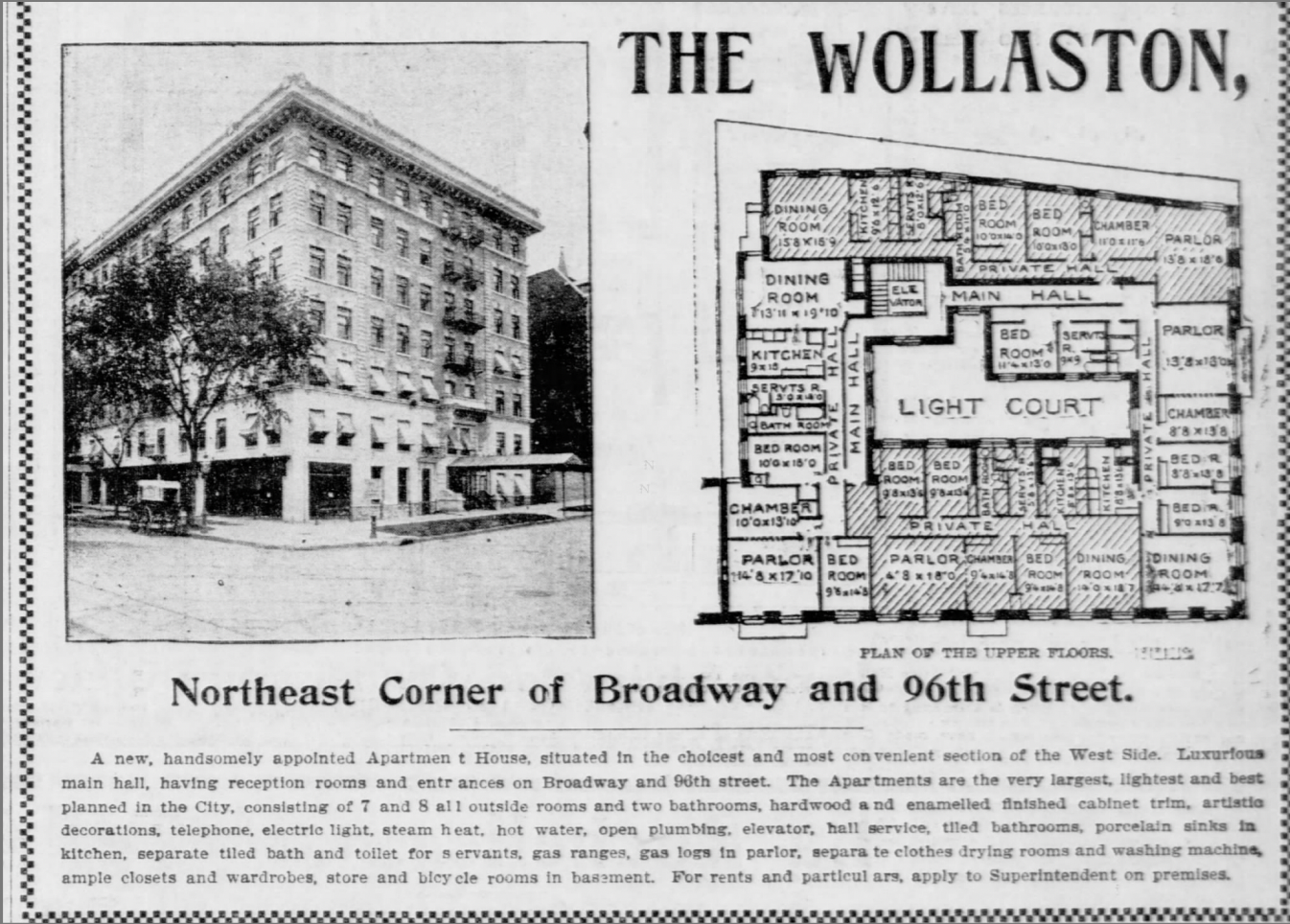
By Pam Tice
Demolition was announced last summer for the building on the northeast corner of Broadway and West 96th Street, dubbed the Wollaston at its opening but known by other names over the years. No timetable was given, nor does there appear to be any public announcement yet of what will replace the building currently known as the Ancott – though judging by recent Upper West Side history, “luxury housing” might be a good guess.
It was built in 1899, and an item in the New York Tribune the following year touted the Wollaston as “a new, handsomely appointed Apartment House” located in “the choicest and most convenient section of the West Side.”
The original name has always connected with me, as I grew up in Wollaston, a part of the city of Quincy, Massachusetts named for Captain Richard Wollaston. Wollaston was an English sea captain and sometime-pirate who was famous for his inability to get along with the Pilgrim fathers in Plymouth, Massachusetts. Among his transgressions: he established a settlement known for celebrating spring with maypole dances, a scandalous practice to the Pilgrims..
Though it was the Wollaston originally, new owners changed the name to the Metropolitan in the early 20th century, according to Landmark West (but the New York Tribune was still calling it the Wollaston at least as late as 1912). And though the building didn’t move, the address also changed; once designated 231 West 96th Street, it is now 2560 Broadway.
When the Wollaston opened, the ad in the New York Tribune highlighted the expected amenities of apartment living at the turn of the last century. The ground floor featured a luxurious main hall with reception rooms. Each apartment had seven or eight rooms, with all “on the outside.” There were two bathrooms in the apartments; one of them was for servants. The bathrooms were tiled and had porcelain sinks, as did the kitchens, equipped with gas ranges. The parlor fireplaces used gas logs, and the units had hot water, electricity, and steam heat. The seven-story building had elevators and “hall service;” the latter apparently meaning there were spaces available to rent for special events. In the basement were separate clothes drying rooms, washing machines, storage rooms, and a bicycle room.

One of the stores located in The Wollaston by 1901 was A.B. Baltzley’s Pharmacy. At the time, prescriptions were custom-made by hand for each patient; later, drugs would be manufactured and sold at a pharmacy. Baltzley’s was also a postal station where customers could buy a stamp or a money order or send a package by registered mail. Mr. Baltzley died of a heart attack in his store in 1911, but the business continued to advertise through the 1920s.
One of the most interesting couples who lived at The Wollaston in its first decade was Captain John Calvin Martin and his wife Emilie. Captain Martin, the son of a wealthy Pennsylvania family, was a veteran of the Civil War. After the war, he built a fortune from land holdings with timber and coal resources. Martin endowed a foundation for Christian education and founded a training school for nurses that he named in honor of his wife.

Martin was a trustee of the Society for the Suppression of Vice in New York. Mrs. Martin was head of the Francis E. Willard Women’s Christian Temperance Union branch, which held regular meetings at 231 West 96th Street and worked to suppress “intoxicants” and, later, cigarettes. In 1908, the group focused on American literature, calling it a “national embarrassment” and campaigning to ban books from public libraries if they depicted a hero or heroine smoking or drinking liquor.
In 1910 Martin was found to be insane, according to his obituary, and was committed to an asylum. He died in 1912. Emilie Martin died the following year.
More tales of some of the colorful residents of the Wollaston are told at the Landmark West site, which uses the Metropolitan name for the building.
Pam Tice is a member of the Bloomingdale Neighborhood History Group www.
Subscribe to West Side Rag’s FREE email newsletter here. And you can Support the Rag here.









Those who cannot remember the past salivate to bulldoze it.
You remember 1899? Or 1910? The building has run its course it’s time to replace it.
And what happens when you run your course?
Don’t forget that the building also existed in 1979; I remember it from then forward.
But thanks for the illustrative example.
“run its course” how?
Love this history. Thank you for your research.
Thank you for this excellent piece and glimpses of the past. Shocking Maypole dances! Prescriptions made to order!
Courtyard buildings are lovely, hopefully the new building will include even more units
I wonder if people diagnosed as “insane” in bygone days and committed to asylums were suffering from Alzheimer’s or senile dementia.
At 67 Captain John Calvin Martin would have been on younger side for a diagnoses of senility or Alzheimer’s. Families then usually did all the could to keep persons out of mental institutions unless absolutely necessary. That is care at home was not possible despite having financial and other means to do so.
Common cause of “insanity” diagnosis at this time and for many years before and after was latent venereal disease infection, specifically syphilis which leads to neurosyphilis.
Some forms of latent neurosyphilis do not appear until between 3 to 50 years after initial infection. Thus, it wouldn’t nor wasn’t uncommon for persons infected when in late teens or sometime in their twenties not to come down with “insanity” caused by said infection until many decades later.
Thoughtful and plausible speculation, although it sounds as though their overreaching constrictions and censures were as unbalanced and misguided as their “religion-y” presumptuous descendants today.
Excellent point.
Another luxury building? Why not affordable housing, for a change? And a change so badly needed. The UWS is fast turning into the UES.
We’d be so lucky to turn into the UES. Been there lately? Plenty of commercial occupancy, great restaurants, clean, quiet. Bring it on!
UES has become a soul-less canyon of unremarkable condo high rises. Any charm or personality it may have possessed has been bulldozed. But yes they do have an Old Navy.
Really? The number of vacant stores on E.86th east of Third Ave is an eyesore, including a movie theater. Not particularly “clean and quiet.”
Can you explain why the Upper West Side is more expensive?
Housing is always affordable, the question is for whom? What you are asking for is low priced housing. It makes no sense to build it in Manhattan with very high prices when you can build 3x the apartments for the same price in Staten Island or the Bronx.
Hall service usually meant coffee, tea and cakes were served in the hallways off a trolly throughout the day, or the cart was left in the hall for self-serve.
Thanks!
So sad to lose another older 7-story building — this one from 1899 no less. Thank you for your well researched and fascinating history of this building soon to be lost.
P.S. I loved the list of amenities!
I don’t understand the snark about this being replaced by luxury housing when this building was … luxury housing? This whole article is about how the building boasted of its servant quarters and its most famous resident was a right wing culture warrior coal baron!
Every building has a history, that doesn’t mean that every building is historically significant.
Give it just a few years and people will be nostalgic for whatever building replaces this one. Look at how people love the old pictures of the UWS in the 1970s (including me!) – an era that people for a very long time talked about being one of our less stylish decades!
That’s a great point, this building illustrates that new housing is often quite expensive (“luxury”) and naturally becomes more affordable over time.
The new buildings will never have stories like these written about them in 100 years.
Wait. 20 W. 96th? So at that time the building numbers were not based on how far they were from 5th avenue? 20 West 96th now would be right off Columbus.
231 W. 96th.
I thought Landmark buildings over 100 years old were protected. Is this no longer true?
Unfortunately, there is no automatic landmarking simply by virtue of age. The landmarking process is long and arduous, and developers have much more clout that landmark enthusiasts.
In this town it’s all about money, any rule can be broken for the richest person and in this case, real estate developer. Remember Trump with Bonwit Teller?
This building is not officially landmarked.
The corridor of B’way between ~92nd and ~100th street is the saddest, most rundown part of the Avenue. Now, I’m no fan of gentrification, but it is clear from what has been happening over the past couple of years (it actually started just prior to the pandemic) that developers and merchants are seeing this, too. And since it is well above the so-called “Gold Coast” (b/w 72nd and 86th Streets), real estate prices are cheaper, so the corridor is ripe for developing. In this regard, it doesn’t surprise me that 96th Street (which is in the middle of the corridor, and the largest cross street) would be targeted. We already have at least two new buildings below it, so none of this is surprising.
It is also interesting that developers are only developing the West side of the Avenue (at least for now).
Still, it would be nice to see one or more of the new buildings be targeted for affordable (truly affordable) housing. I hope our electeds are considering this.
Broadway is a Boulevard, so is Park Avenue north of Grand Central at least. It’s the trees.
Quality of life is a two way street, there are wealthy cultural deserts and there are poor cultural deserts. Jane Jacob’s would be rolling in her grave to see how the city has been auctioned off after all that she did.
Jane Jacobs and her husband were in the 1% when they bought their Greenwich Village townhouse. It had been a multi dwelling building that they converted to single family. The took over the immigrant-run grocery on the ground floor to expand their living space, and remodeled the front of the building in a way that was out of character with the rest of the block. Then she advocated against any changes other people wanted to make to their property, and against any development in the area. This resulted in little new housing being built and over time pushed the non-rich out of the Village.
I’m glad the Lower Manhattan Expressway wasn’t built, but her full legacy includes the exclusion of the working and middle classes from an entire neighborhood.
Hopefully a new taller luxury high rise will go there.
Interesting that the “parlor” (in modern terms, the living room?) was at the opposite end of the apts from the dining room. Maybe for reasons of size and windows?
During Victorian era parlour was usually the front room of a middle class home that was formally decorated and used largely for receiving guests and other formal or special occasions. Weddings then held at home were held in front parlours. Ditto for laying out of the dead, wakes and funerals. Funeral homes aren’t also called “parlours” for no reason. *LOL*
By early 1900’s move began towards more relaxed living and with a push from Ladies Home Journal by WWI era palours became “living rooms”.
Above being said many of us who grew up in a certain era (am talking well into 1980’s) knew the deal. Like front parlour of old *no one* was allowed in the living room. *LOL*
Outside of major holidays or special guests mother declared living room was off limits. People gathered in the kitchen, we kids had a rumpus room or our bedrooms.
We are living on the Ship of Theseus. When will it no longer be the “ship” we remeber and be something all together new that won’t even be called the UWS? Anybody have some clever real estate monikers they wan’t to propose?
Remember a few years ago, when racist, classist, tasteless brokers and developers proposed “rebranding” W.110th to ~W.124th as SoHa (South Harlem)? It took several demos attended by local pols to prevent that one!
I’m curious – why is that racist? I get that it is tasteless, but I don’t see how it denigrates anyone’s race?
So touched that the Wollaston, just two blocks from my home is connected to my hometown of Quincy and many memories of Wollaston, both the beach and the downtown area.
Another piece of the visible sky, gone, along with the history. Yes, these were the luxury buildings of the time, but there were also far more opportunities/space available to build non-luxury housing.
Was there a connection between Captain Martin’s suppression of vice and his eventual insanity?
Much like today, every accusation is an admission! 😂
Serenity now, insanity later!
Which came first?
I find it amazing that European cities take pride in their cities and mostly rebuild in the stile that the building originated in. We just put up aluminum and glass. Boring but quick money. It’s a shame. We tourists go to those cities to see those wonderful buildings. We were so lucky to get many of the European artistic builders around the turn of the century. I am always amazed at the special artistic design of so many of our buildings built during that period.
I’m in Frankfurt right now and spent the weekend in Heidelberg. Totally agree with you, the architecture of the past is so much more beautiful and full of character and stories.
No one will remember or care about these glass towers when their time comes to be replaced. They are plain and boring and most people I know that live in one are always complaining about how poorly they are built.
Wow, thank you, history’s so interesting. The Martins were a colorful couple, weren’t they?
Great. That intersection needs it. Hopefully something nice can be built on the Southeast corner too.
Tagging on to two other recent WSR threads; West End Avenue and UWS Stoops, development of multi-family such as the Wollaston hastened demise of rowhouse living for UWS families.
By early 1900’s and certainly by 1910 through maybe 1939 these middle to grand apartment houses became preferred residences for middle and above class families.
Comparing square footage many of these apartment buildings offered same room as rowhouses, but all on one level rather than several.
Amenities such as steam heat, hot water (taps), washing machines and clothes dryers (of a sort or at least laundry room), gas ranges, gas fireplaces and more were not something all rowhouses had. More over cost of renovation to add such mod cons wasn’t always in homeowner’s budget.
With opening of subway along Broadway in 1904 property values rose not just for that street but WEA and Columbus as well. Owners of rowhouses were often happy to unload those piles for tidy sums and move into an apartment building.
Great story Pam. Thanks!
Interesting story. Thanks!
Great write up. I am curious about the progress on this building (good or bad) . Some of the paper came down from the old Chase Bank windows shortly after the demo was announced and then it seems like nothing ever since.
Yada yada yada.. Sell your precious UWS apartment well before global warming starts submerging your investment under water. Then you’ll be happy you bought in Babooshki, AK.
This is sad to hear but not surprising considering what’s become of the neighborhood. I lived in the Ancott for 13 years until our lease was not renewed in 2020, it was clear then what the owners had in mind for the building. Any tenants they could get out they did. The area has become a ghost town in the past 4 years. Just soulless glass towers and closed stores.